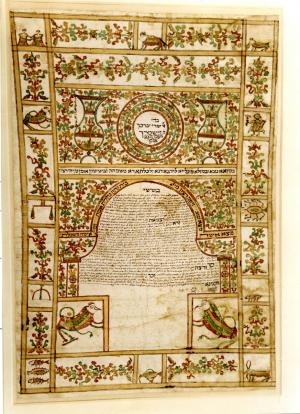Obj. ID: 5751
Sacred and Ritual Objects Marriage contract, Ioannina, 1813

Bride:
"העלמה היקרה והנעלה נימאסו בת הרב ישולה."
"The dear exalted girl, Nimassu the daughter of Rabbi Yeshulah."
Groom:
"הבחור הנחשב ב''ר (בן הרב) עננייא בן רבי נחמן עננייא."
"The appreciated youth, the son of the Rabbi Anann' ia (?), the son of the Rabbi Nahman Anann'ia."
Date:
בשישי בשבת ארבע עשר יום לחודש חשוון שנת חמשת אלפים וחמש מאות ושבעים וארבע לבריאת העולם ושנת אלף שבע מאות וארבעים ושש לחרבן בית המקדש, שיבנה במהרה בימינו"
"On a Friday (see: Remarks: no. 2) 14th of the month Heshvan in the year 5574 to the creation (7.11.1813), and the year 1746, to the destruction of theSecondTemple ( 68 – according to the local counting = 1814), may it be established soon, amen."
Place of marriage:
"עיר פה בק''ק (קהל קדוש) יאנינא."
"Here, in the Holy Congregation ofIoannina,Greece"
|
Witnesses: - Solomon David Kabbali (the extreme right signature; see: Remarks: no. 2; fig. 1) - Isaac Kabbali (the extreme left signature, fig. 1) - Two additional unidentified witnesses. |
|
|
|
Fig. 1. Ketubbah, Ioannina, 1813. The signature of the witnesses
|
The rectangular ketubbah encloses the traditional text within a horseshoe arch standing on two small pillars. It is topped by a medallion inscribed with the Priestly Benediction, and is framed by the Zodiac signs.
Below each pillar is a large square enclosing rampant lions, revealing their tongues and facing each other. A narrow band shaping the arch is inscribed with two verses:
"'מצא אשה מצא טוב ויפק רצון מיי' (משלי יח:כב)/ 'בית והון נחלת אבות ומיי אשת משכלת' (משלי יט:יד)."
“’Whose findeth a wife findeth a good thing, and obtaineth favour of the Lord’ (Prov. 18:22);
‘House and riches are the inheritance of the fathers, and a prudent wife is from the Lord’ (Prov. 19:14)."
A narrow strip above the arch is inscribed with the Aramaic blessings:
"בסימנא טבא ובמזלא מעלייא לחתנא דנא ולכלתא דא בשמחה ובששון אמן כן יהי רצון."
“With a good omen and great fortune to this bridegroom and this bride in joy and in mirth, amen, may it be His will.”
Above it, are three rectangular panels; the upper two decorated with foliate branches, and the wider lower has a central medallion flanked by two vases, set against a floral background. The medallion framed by three concentric floral bands is inscribed with the Priestly Benediction:
"בה' (בעזרת השם)/ אל שדי יברכך/ ה' וישמרך/ ייפאו (יאר ה' פניו אליך ויחנך) ייפא (ישא ה' פניו אליך)/ וילש (וישם לך שלום)." (במדבר ו: כד-כו).
“The Lord blesses thee, and keeps thee. The Lord maketh his face shine upon thee, and is gracious unto thee. The Lord lifts up his countenance upon thee, and gives thee peace." (Num. 6:24-26)
The entire ketubbah is framed by a band with rectangular sections enclosing the zodiac signs interspersed with floral motifs, alternately. Three Zodiac signs are set on the top and bottom bands and three on each side. The top signs start with the month of Nisan from right to the left (fig. 2):
|
|
|||
|
Fig. 2. Ketubbah, Ioannina, 1813. The signs of Lamb, Bull and Twins
|
|
||
|
The Lamb (Aries) is depicted as a sheep eating grass; the symbol of Iyar is a bull; the Twins of Sivan are frontal figures holding hands dressed in coloured dresses (fig. 2). The following signs are set in opposing panels on the right and left bands, (mistakenly the Virgin and Cancer are reversed; fig. 4). In the lower row from right to left (fig. 3: the Kid of Tevet is a bearded horned goat; a jug from which water is poured, is the Bucket of Shevat; and three Fish, represent the month Adar.
|
|||
|
Fig. 3. Ketubbah, Ioannina, 1813. The signs of Kid, Bucket and Fish
|
|||
|
|
Fig. 4. Ketubbah, Ioannina, 1813. The signs of Virgin, Lion, Cancer, Scales, Scorpion and Bow |
||
- The ketubbah is unique in its naïve style and combines the iconography of the Italian ketubbot in the depiction of the Zodiac signs, with the visual as well as the textual traditions of marriage contract made in Ioannina (see also: Custom). The Ioanninan characteristic features are apparent in the horseshoe arch, framing the single column text, as compared to the Ioanninan ketubbah of 1787 (Jerusalem, National and University Library, no. 0150868). Salomon David Kabbali, one of the witnesses in this contract is the same person who witnessed the marriage of our 1815 ketubbah.
As mentioned in the Custom, the Romaniot rite known as Minhag Corfu (the rite of Corfu) includes a unique clause stated by the bride, who promises: "to honor him and serve him in cleanliness and purity, as decent and modest Jewish women…" (lines 10-11). An additional textual component typical to Greek Romaniot ketubbot is the appearance of a double dating system: they preserved the early tradition calculating the years from the destruction of the Second Temple (the year of the destruction is mistakenly considered to be 68, see: Sabar, Ketubbah, pp. 236; 257- 258). Along with the calculation from the creation of the world that is the most frequent era, used in various communities.
- There is a discrepancy between the day and the date; the 14th of Heshvan in 5574 was a Sunday and not a Friday. It is possible that our scribe copied, by mistake the day in the model he used.
Scorpio, the sign of the month Heshvan is not always represented as a scorpion, which was probably a creature not known to Europeans, but as a reptile or monstrous animal, see: Amar, Ingathering, p. 50.











